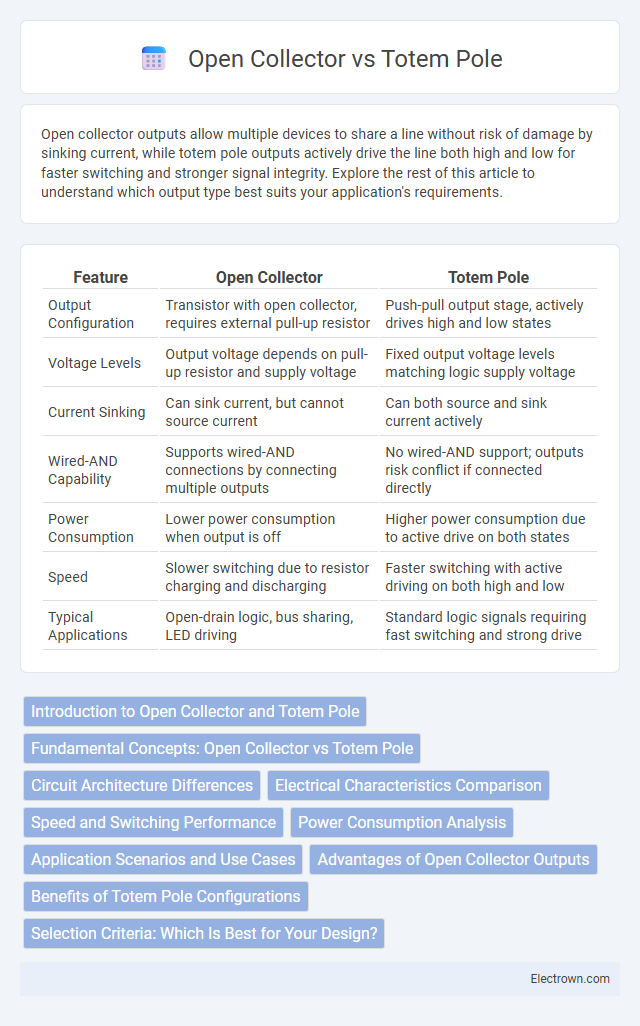Open collector outputs allow multiple devices to share a line without risk of damage by sinking current, while totem pole outputs actively drive the line both high and low for faster switching and stronger signal integrity. Explore the rest of this article to understand which output type best suits your application's requirements.
Table of Comparison
| Feature | Open Collector | Totem Pole |
|---|---|---|
| Output Configuration | Transistor with open collector, requires external pull-up resistor | Push-pull output stage, actively drives high and low states |
| Voltage Levels | Output voltage depends on pull-up resistor and supply voltage | Fixed output voltage levels matching logic supply voltage |
| Current Sinking | Can sink current, but cannot source current | Can both source and sink current actively |
| Wired-AND Capability | Supports wired-AND connections by connecting multiple outputs | No wired-AND support; outputs risk conflict if connected directly |
| Power Consumption | Lower power consumption when output is off | Higher power consumption due to active drive on both states |
| Speed | Slower switching due to resistor charging and discharging | Faster switching with active driving on both high and low |
| Typical Applications | Open-drain logic, bus sharing, LED driving | Standard logic signals requiring fast switching and strong drive |
Introduction to Open Collector and Totem Pole
Open Collector and Totem Pole are two common output configurations in digital electronics, each with distinct operational characteristics. Open Collector outputs utilize a transistor connected to ground, allowing multiple outputs to be wired together for wired-AND logic, requiring an external pull-up resistor. Totem Pole outputs consist of both a push-pull transistor pair that actively drives the output high or low, providing faster switching speeds and stronger drive capabilities.
Fundamental Concepts: Open Collector vs Totem Pole
Open Collector outputs rely on a transistor that can sink current but requires an external pull-up resistor to drive the line high, making them ideal for wired-AND logic and level shifting applications. Totem Pole outputs integrate both sourcing and sinking transistors within the device, allowing for faster switching speeds and strong drive capability without external components. Understanding these fundamental differences helps optimize your circuit design for speed, power consumption, and signal integrity.
Circuit Architecture Differences
Open Collector circuits use a transistor with its collector exposed externally, allowing multiple outputs to be connected to a common line for wired-AND logic, resulting in a configurable and flexible pull-up behavior. Totem Pole outputs feature a push-pull configuration with two transistors in series, providing both sourcing and sinking capabilities for faster switching and stronger drive currents. Your choice between these architectures impacts signal integrity and load handling, with Open Collector offering simple wired logic and Totem Pole delivering faster, actively driven outputs.
Electrical Characteristics Comparison
Open collector outputs provide a sinking current path and require an external pull-up resistor, resulting in slower rise times and limited voltage levels. Totem pole outputs actively drive both high and low states, enabling faster switching speeds and strong drive capability with well-defined voltage levels. For your circuit design, choosing between open collector and totem pole depends on the desired speed, voltage compatibility, and load-driving requirements.
Speed and Switching Performance
Open collector outputs offer slower switching speeds due to their reliance on external pull-up resistors, resulting in longer rise times. Totem pole configurations provide faster switching performance by actively driving both high and low output states, minimizing transition delays. This active drive capability in totem pole circuits significantly reduces propagation delay and improves overall speed in digital applications.
Power Consumption Analysis
Open collector outputs consume less power during static states because they only sink current when active, avoiding continuous current flow typical in totem pole configurations. Totem pole outputs draw more power due to both pull-up and pull-down transistors being partially active, causing higher quiescent current and increased dynamic power dissipation. In low-power applications, open collector designs offer significant power savings despite slower switching speeds compared to totem pole circuits.
Application Scenarios and Use Cases
Open collector outputs excel in wired-AND logic configurations and are ideal for interfacing multiple devices to a single line, especially in interrupt or bus sharing scenarios common in industrial control systems. Totem pole outputs provide faster switching speeds and are preferred in high-frequency digital circuits and microcontroller I/O pin driving applications requiring push-pull operation. Open collector is favored for level shifting and driving loads requiring higher voltage or current, while totem pole is suited for direct logic signal generation and low output impedance needs.
Advantages of Open Collector Outputs
Open collector outputs offer the advantage of allowing multiple devices to share a common bus without risk of damage due to their wired-AND configuration, enhancing system flexibility and simplifying communication protocols. They enable level shifting and can interface with different voltage levels by using an external pull-up resistor, making them ideal for mixed-voltage environments. You benefit from reduced power consumption and increased robustness against short circuits compared to totem pole outputs, especially in open-drain configurations.
Benefits of Totem Pole Configurations
Totem pole configurations offer faster switching speeds and improved efficiency by actively driving both high and low output states, unlike open collector outputs that rely on external pull-up resistors. This results in reduced power dissipation and better signal integrity, essential for high-frequency digital circuits. Your designs benefit from cleaner output waveforms and lower propagation delays with totem pole configurations.
Selection Criteria: Which Is Best for Your Design?
Open collector outputs excel in applications requiring wired-AND logic and easy interfacing with different voltage levels, making them ideal for open-drain communication buses and multi-device signaling. Totem pole outputs provide faster switching speeds and stronger drive capabilities suitable for driving LEDs or digital inputs directly, offering low output impedance and reduced power consumption in high-speed digital circuits. Selection depends on specific design needs such as speed, load driving requirements, voltage compatibility, and whether multiple outputs need to be connected without conflict.
Open Collector vs Totem Pole Infographic

 electrown.com
electrown.com